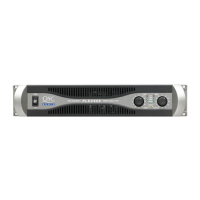Troubleshooting “TOP-210” Bias Supply.
QUICK TEST OF BIAS SUPPLY.
Ramp the AC voltage up slowly to 25% of regular voltage (30V for
12OV
unit). If the bias supply is working
normally, the green “power” LED should come on between 30 and
35V,
with its usual, steady
“half-brighf’
start-up level.
CAUTION: if the LED comes on at
2OV,
or not until
5OV,
or blinks, DO NOT RAISE VOLTAGE PAST 60V
until you have measured the bias voltage. The switching will not start until you reach
9OV,
so you can save
the
IGBT’s
from blowing.
Confirm that bias voltage at Cl38 is
18-19V.
BIAS SUPPLY VOLTAGE MUCH TOO HIGH
D63,64,65,66,67
or R349 open or missing -- breaks feedback to U16
NO BIAS SUPPLY VOLTAGE
U16 missing or blown.
Tl missing, reversed, or open primary
D62 open or missing.
BIAS VOLTAGE ERRORS
The exact voltage is controlled by the feedback through
D63,
64_
65, 66, 67 and R349 as follows:
Cl38 is the
“+18V’
rail with about
18.8V
typical.
D63,
64, 65 each subtract a diode drop
(0.7V)
from Cl38.
Cl39
,
is the
“+16V”
rail with about
16.6V
typcial.
D66,
a
IOV
zener
diode
,
plus diode
D67,
subtract about 1 IV from
+16.6V.
R349 subtracts about
0.5V,
bringing the net voltage at
Ul6,
feedback pin 4, to about
5.lV.
Ul6
uses this feedback to adjust the “on” time at pin 5, in order
toraise
or lower the
flyback
voltage
charging Cl38 and thus maintain regulation of the
+16V
and
+18V
supplies
C142,
R356,
and R349 form a closed-loop stability circuit which prevents the regulated voltage from
“hunting”.
Q99
and associated R374 reduce the voltage of the Bias supply by 33% when the AC voltage is turned off.
This prevents the Power LED from showing at half brightness after turn-off, since U16 continues to run
from the main filters for some time after shut down R375 and 376 sense the output of
Ul3:3,
the “Loss of
AC” comparator, and cause
Q99
to turn on. If
Q99
is shorted, the bias voltages will remain 33% low when
AC is turned on.
REPLACING BLOWN TOP-210.
If U16 has blown, check T-l for continuity after removing
Ul6.
Its primary may be open. Pins I-2 It should
measure about 15 ohms
Replacing Blown Output Transistors
OUTPUT TRANSISTOR SHORTED
Stmrk
in one device tend to cause the opposing device to blow as
well,
If an output transistor shorts:
Drive transistor will be shorted
(Q26,
Q27,
Q71,
Q72)
CXNne
transistors will short in pairs (Q39
&
Q40,
Q36
&
Q37,
Q84
8
Q85,
Q81
8,
Q82)
The rest will short in fours
(Q28,
Q29,
Q34
&
Q35;
Q73,
Q74,
Q79
8,
Q80)
IGBT’s
8 their associated components may
fail
14

